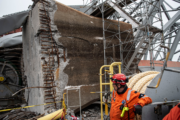WASHINGTON — The Capital Beltway has a reputation as a roadway where drivers are participating in an aggressive, competitive sport. The road itself is nicknamed the “Capital Speedway,” and some refer to its windiest pass through Rock Creek Park as the “Capital Roller Coaster.”
The 64-mile loop around D.C. remains one of the more likely places for a D.C.-area driver to encounter, or be involved in, an accident.
Newly released numbers from the Virginia Department of Transportation and the Maryland State Highway Administration show that over the last few years, the greatest number of crashes and fatal crashes on the Capital Beltway happened in Prince George’s County. The counts in Virginia and Montgomery County were significantly lower.
The highest concentration of crashes was on the segment between the Interstate 95 Interchange in College Park and the U.S. 50 Interchange in Landover.
This “danger corridor” saw an annual average of 54.3 crashes per mile per year between 2010 and 2012. The records show 1,239 crashes happened along the 7.6 miles of Interstate 495 between College Park and U.S. 50 during the three-year period, 450 (59.2 per mile) in 2012 alone.
Along a section of the Beltway known for its chronic congestion in Montgomery County, there was an average of 41.4 crashes per mile over three years. A three-year total of 2,004 accidents were archived in the roughly 16-mile segment between I-95 and the American Legion Bridge. In 2012, there were 635 collisions (39.7 per mile).
The majority of these incidents were rear-end collisions, indicative of drivers following too closely, says David Buck, a spokesman with the Maryland State Highway Administration.
“In some ways, the more congested interstates are bound to have less severe crashes, as the speeds are much lower and it’s all relative to the number of vehicles on the road in any given day,” Buck says.
Some parts of the Beltway in Montgomery County carry as many as a quarter-million vehicles daily.
“In a society driven by deadlines, unfortunately, people look to cut corners and make up time on all roads,” Buck says.
VDOT’s database, provided by the Department of Motor Vehicles, shows that the number of crashes over the last three years on the Beltway in Virginia has dropped since the completion of the I-495 Express Lanes and the Woodrow Wilson Bridge projects.
In 2011, a grand total of 1,514 accidents occurred on the Beltway between the Woodrow Wilson and American Legion bridges. In 2012, that number dropped to 1,174. After the dust from the construction settled, the crash count fell to 950 (43.2 per mile) by the end of 2013.
The southeastern side of the Beltway in Maryland, between the Woodrow Wilson Bridge and U.S. 50, saw significantly fewer crashes annually, according to records from Maryland State Police Forestville barracks. In its 18.5-mile-long patrol area, 1,592 crashes were documented over three years — an average of 28.6 incidents per mile per year.
The numbers in both states represent all collision types, ranging from fender benders to more serious wrecks. Accidents on the Beltway’s on-ramps and off-ramps were excluded. Crash data on the Beltway in Maryland in 2013 were not yet available.
Although the crash rate was lowest on the Beltway through Oxon Hill, Forestville and Landover in Prince George’s County, the data show fatal accidents occurred there more often than any other section of I-495. Sixteen deaths were documented between 2010 and 2012, nearly one for every mile between the Wilson Bridge and Route 50.
There were three fatal accidents between Greenbelt and College Park and 11 in Montgomery County during the same period.
Virginia State Police have documented only two fatal accidents on the mainline of the Beltway since 2011.
East of the Woodrow Wilson Bridge, the straightaways and smooth curves on the southeastern side of the Beltway have a long history of playing host to reckless behavior, says AAA Mid-Atlantic Manager of Public and Government Affairs John Townsend.
“Because of its design, configuration and contours, many drivers regard the Prince George’s section of the Beltway as their personal speedway, and that’s a dangerous attitude,” Townsend said in a 2010 study on fatal crashes on I-495 in Maryland.
The study found an enhanced speed-enforcement initiative by Maryland State Police led to a significant decline in the number of fatal accidents by late 2010. However, the number of fatal crashes on the Beltway is only slightly lower today than when the study was conducted.
When presented with the latest data, Townsend said, “the thing that jumps out at me is that we still have more crashes on the Maryland side of the Beltway day in and day out. Sixteen fatalities over the span of three years is still unacceptable, and it exposes the risk that you face [when driving] on the Beltway.”
He acknowledges that as the war on aggressive driving wears on, the war on distracted driving has just begun. A number of the most recent accidents on the local highways, including the Beltway, have been linked to cellphone use.
“With the congestion we have the Beltway, so many cars, the margin of error is very small,” Townsend says.
“You have high traffic volumes and too many motorists who are too impatient.”
Follow @WTOP and @WTOPTraffic on Twitter and WTOP on Facebook.







